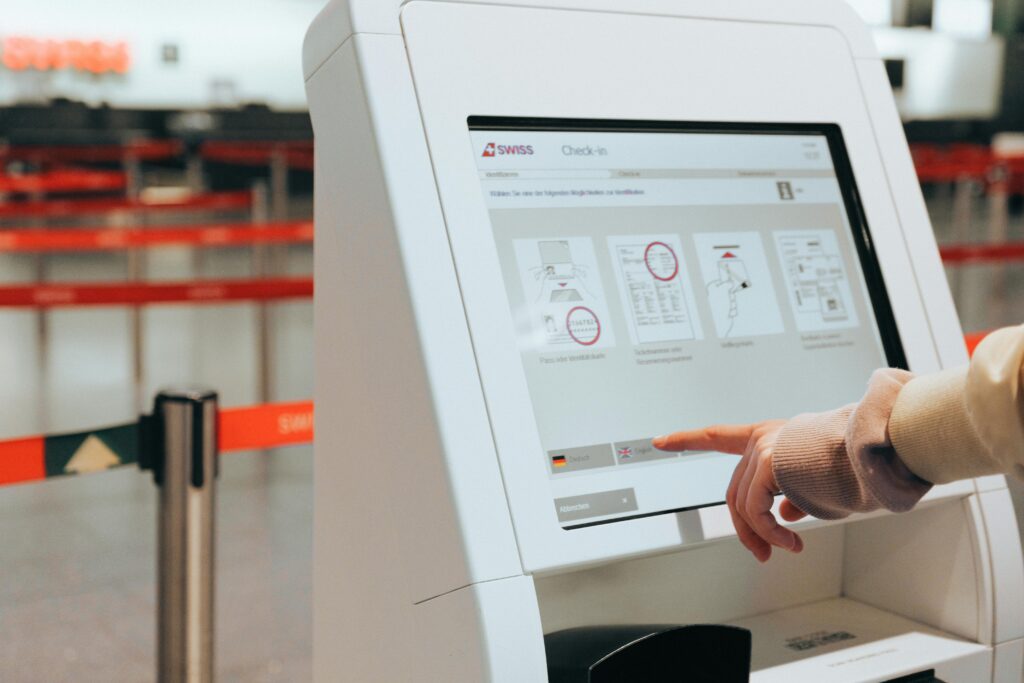Touch screens have become nearly ubiquitous in modern technologies, from smartphones and tablets to retail interfaces. They now practically dominate multiple markets, becoming a central component in modern human-machine interfaces, including consumer electronics, industrial controls, and even military systems.
However, when manufacturing any new touch screen device, one has to make a choice between two dominant touch sensing technologies: resistive and capacitive. Each of these systems offer unique benefits and limitations, which can make them each the best choice depending on the application you’re using them for.
Here, we’re going to take a closer look at both resistive and capacitive touch screens, what you need to know about them, how they compare, and the ideal use cases based on the pros and cons of their underlying technologies
1. Resistive Touch Screen Explained
First, let’s start by defining and explaining each of the technologies. Resistive touch screens operate based on analog switch technology. They are comprised of several layers that work together to detect touch input through physical pressure. Their primary components typically include the following:
- Top Film: Usually a flexible layer of PET that is designed for users to directly touch.
- Top Electrode: This is an Indium Tin Oxide (ITO) conductive coating on the underside of the top film.
- Air Gap: A space layer between the electrodes that contains tiny dielectric dots, keeping the layers apart when they’re not being touched.
- Bottom Electrode: A matching ITO-bcoated layer that forms the second half of the circuit.
- Display: An LCD or other display panel that shows the visual interface beneath the touch layers.
When a user presses down on the screen, the top layer flexes and makes contact with the bottom electrode, closing the circuit at that location. The controller then calculates the X and Y coordinates by applying a voltage gradient across one axis and measuring the resulting voltage on the other. For 4- and 8-wire systems, the voltage is alternated between layers, while 5-wire systems keep the bottom layer constant, using the top layer to read voltage gradients instead.
Usually, the PET top layer is vulnerable to issues like scratches, water ingress, and wear over time. Due to PET’s high flexibility, cracking of the ITO conductive layer is prone to happen over time. To address this, A D Metro’s ULTRA Armored touch screen uses a glass/PET composite that replaces this layer, improving the overall durability while resisting vandalism. It also is stiffer and minimizes sharp bending that causes ITO cracking, prolonging sensor life by as much as ten times over regular resistive. It’s also waterproof, so it can be used in all weather conditions. On top of that, it’s still responsive enough to maintain switch integrity without compromising tactile responsiveness.
2. Capacitive Touch Screens Demystified
The other type of technology most commonly used is capacitive touch screens, in particular Projected Capacitive (PCAP) technology. Rather than detecting touch by changes in pressure, they sense it through changes in capacitance (the storage of electrical charge). They are typically comprised of the following components:
- A glass substrate coated with a grid of conductive materials like ITO or ATO.
- The grid forms X and Y electrode lines, either etched directly or created using embedded metallic filaments.
- A top protective glass cover is laminated over the sensor grid.
- An AC field is applied to the conductive grid.
When a conductive object, whether that’s a human finger or a specially designed stylus, approaches or touches the screen, it disrupts the electrostatic field of the sensor grid. The controller then identifies the specific location by analyzing which point of the grid is experiencing the most field distortion.
Capacitive screens are extremely durable and reliable, continuing to function unless the conductive grid itself is physically damaged. They also enable touch operation through protective layers or even thick glass windows. PCAP sensors are unaffected by dust and debris, support multi-touch gestures, and offer sleek, modern interaction experiences.
That said, capacitive technology does come with some issues, such as being susceptible to false touches from water or other conductive contaminants. It can also make the technology difficult to operate if wearing gloves or when using in wet environments. The AC field in the touch screen also generates electromagnetic interference, which can be a problem in sensitive applications, such as medical equipment or military systems.
3. Key Differences Between Resistive And Capacitive
There are several differences between resistive and capacitive touch screens, many of them stemming from the two technologies that lie at the core of their activation touch methods. Some of the differences are as follows:
- Material-wise, standard resistive screens use flexible polyester, while A D Metro’s ULTRA variant uses a thin glass composite. Capacitive screens, on the other hand, rely on rigid glass with etched conductive layers, which enhances durability but restricts their mechanical flexibility.
- Resistive touch screens detect input through physical pressure, which connects two conductive layers to complete a circuit. On the other hand, capacitive screens use electrical fields and sense changes in capacitance from a finger or stylus. This typically results in more versatility for resistive scenes, while capacitive screens are often faster, more sensitive, and intuitive.
- Resistive screens tend to be better suited for rugged environments and can be used with gloves, styluses, or any object that applies pressure. Capacitive screens rely on a conductive input and often struggle with gloves or in wet environments unless specially designed.
- Capacitive screens tend to offer more visual clarity as they don’t have an air gap under the surface. The air gap in resistive screens can reflect light which can affect their display brightness and clarity.
- Capacitive touch screens inherently support multi-touch gestures such as pinch-to-zoom and rotation, enhancing user interactivity. Standard resistive screens are typically single-touch unless equipped with advanced controllers. While newer resistive technologies support limited multi-touch, capacitive screens still lead in responsiveness and gesture support for modern, app-driven interfaces.
4. Pros and Cons Of Resistive vs Capacitive Screens
While you may have already seen the potential drawbacks of both types of technology in the points above, let’s lay out some of the practical advantages of both technologies.
Resistive (Standard and ULTRA Armored)
Pros
- Fully waterproof and sustainable for all-weather use
- Ideal for EMI/RF sensitive environments as they’re unaffected by and do not cause interference.
- ULTRA Amored screens offer additional durability and protection due to glass-laminated surfaces.
- Compatible with any control device, including fingers, styluses, and gloves.
Cons
- Contains an air gap in the switch layer, which can affect optical clarity and light transmission.
- Needs physical pressure to activate.
- Standard models are limited to single-touch inputs. Specialized controllers like A D Metro’s 2 Touch are required for multi-touch inputs.
Capacitive (PCAP)
Pros
- Superior visual clarity due to no air gap.
- Durable glass surface that supports sleek, modern interface designs
- Does not require pressure or force and supports multi-touch gestures by default.
Cons
- Prone to false inputs from water or condensing humidity.
- Tough to operate with gloves or in wet environments
- Generates RF noise and is vulnerable to EMI/RFI, affecting reliability in sensitive environments.
- Prone to erratic operation if the display or other electronics the sensor is fitted to emit radio frequencies or RF noise similar to the operating frequency of the touch screen.
- Cannot be fitted with EMI mesh for RF suppression and wouldn’t make any sense since the touch screen itself uses radio frequency to operate and therefore is a source of radio emissions itself.
5. Choosing The Right Touch Screen Technology
The best technology for you depends on a range of environmental, mechanical, and functional considerations. You should think about the application and ask the questions below:
- Will the device be used outdoors or in wet conditions?
- Is potential vandal damage or impact durability a concern?
- Will gloves or styluses be used regularly?
- Are they used in environments where electromagnetic interference is a concern?
- Is optical clarity vital for the user experience?
For rugged, all-weather, or military-grade applications, ULTRA Armoured resistive sensors are often the best fit. They provide unmatched durability, immunity to EMI/RFI, and work with a variety of input tools, even in harsh conditions.
Capacitative touch screens are best in consumer and commercial environments due to their enhanced aesthetics, user interaction, and features like multitouch. This includes controlled conditions like smartphones, tablets, ATMS, and indoor kiosks.
6. Enhancing User Experience With Capacitive Touch Screens
Capacitative touch screens excel in a host of commercial and consumer applications. What’s more, their limitations are actively being addressed by manufacturers that offer surface treatments to enhance their usability. These include the following:
- Anti-Glare (AG) coatings that reduce reflections for outdoor readability
- Anti-Reflection (AR) coatings that improve light transmission and display clarity.
- Hydrophobic coatings that repel water, preventing accidental touches and making them more usable in wet conditions.
These enhancements improve real-world performance, especially in semi-controlled environments where water exposure or fingerprint smudging is a concern.
7. Why Resistive Touch Screens Still Have A Place
Although capacitive technology dominates in consumer markets, resistive touch screens are vital for many industrial, medical, and military applications. The ULTRA Armoured solution offers:
- Waterproof, glove-friendly, and stylus-compatible operation.
- Exceptional life expectancy.
- Exceptional durability against vandalism and rough handling.
- No RF emissions and high immunity to electrical interference
- Not affected in any way by radio frequency noise.
- Can be fitted with EMI mesh to suppress radio emissions for military applications.
- A newer 2 Touch controller enabling multi-touch gestures like pinch, zoom, and rotate.
As such, they are widely used for applications like outdoor kiosks, marine systems, spa controls, and frontline military hardware.
8. The Future Of Touch Screen Technology
As touch screen technology continues to evolve, the kind of hybrid approaches and material innovations will likely continue to mitigate the inherent disadvantages of both technologies. That said, as long as the two technologies have their core differences, then their distinct use cases are likely to remain the same: capacitive for sleek, interactive environments and resistive for rugged, reliable deployment in challenging conditions.



